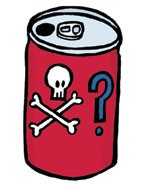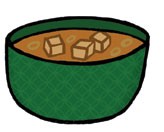We live in a sound-bite culture. Pop wisdom is delivered in snippets, divvied-up TV screens, and crawling word banners at the bottom of newscasts. Blogging has gone micro, and if you can't say it in a 140-character Twitter post then you probably shouldn't say it at all. But there's a price to pay for the current obsession with abbreviation. When our stories are left half told, overgeneralization and misinformation step in to fill empty spaces. Amid the newsflashy free-for-all that is the World Wide Web, myths and rumors run rampant. When it comes to health topics, our edited-out talk loses its hard science. That's why, in defiance of the dumbed down, I've selected a few popular health sound-bite claims for closer inspection. Are the following brazen-faced statements fact, fiction, or something in between? The answers might surprise you.
Cell phones give you brain cancer.
This unlikely seeming declaration is quite possibly true. Last summer, the World Health Organization (WHO) surprised the medical community by reversing its stance on cell phones and cancer. While the international agency—comprising top scientists from around the world—originally drew no link between the two, it is now suggesting a possible connection. After reviewing the evidence from a number of studies, WHO's International Agency for Research on Cancer classified mobile phone use as a "carcinogenic hazard" in the same risk category as lead, engine exhaust, and chloroform. The cause for alarm is that cell phones emit radiofrequency electromagnetic radiation—a nonionizing type of radiation similar to the kind that powers a microwave oven but not as strong as ionizing X-ray radiation. Says Dr. Jonathan Samet, the chairperson of WHO's International Agency for Research on Cancer and the director of the Global Institute for Health at USC, "This classification does not mean there is certainty that mobile phones cause brain cancer. But it reflects the findings of several studies showing associations of mobile phone use with increased brain cancer risk. Thus, the [WHO] group could not classify radiofrequency electromagnetic radiation as not causing cancer."
When we hold cell phones to our ears, are we cooking our brains? Some scientists have suggested that we are—though WHO maintains on its website that radiation from cell phones only negligibly raises the temperature of the brain or other organs. What's harder to ignore is that the largest international study on cell phones and cancer, released in 2010, showed that participants who used a cell phone for 10 years or more had doubled their risk of developing brain glioma, a type of tumor. Given that widespread cell phone use has been a part of our culture for only about the past 15 years, its long-term effects remain unknown. Says Samet, "We need more research to sort this out—both epidemiological and mechanistic."
Bottom line: Cell phones might increase brain cancer risk, but don't toss your BlackBerry just yet. Using a wired earpiece or your phone's texting or speakerphone function—instead of pressing the device against your noggin (Can you hear me now?)—can significantly reduce exposure to radiation from the gadget.
Chocolate is good for you.
The short answer is yes—but hold your applause. Study after study has revealed the positive nutrient attributes of flavonoids, the health-promoting antioxidants so richly abundant in dark chocolate. Says Jeffrey Blumberg, PhD, professor of nutrition science at Tufts University and a lead researcher on several chocolate studies, "The evidence from a number of studies now—both observational studies and meta-analyses of clinical studies in chocolate—all suggest an improvement in vascular function seen in part by things like a decrease in blood pressure, particularly in people who have high blood pressure. That's definitely a good thing. Cocoa powder, or dark chocolate with lots of cocoa powder in it, can have these benefits." But. (And there's always a but, isn't there?) "Chocolate is also a high-fat, high-sugar food," cautions Blumberg. "Too much can lead to weight gain and obesity. So the good news is, dark chocolate is good for you. The bad news is, you can't eat as much as you want."
What about milk chocolate? The jury is out on that popular confection. Some studies say that flavonoids bound with milk lose their bioavailability (or their ability to be absorbed by the body), while other studies have failed to identify this untoward reaction. "If I put milk in my chocolate or tea, do I lose the benefit? The answer is not clear," says Blumberg. What we know for sure is that milk chocolate is not very high in flavonoids because the Dutching process removes them for a smoother, sweeter taste. (You can thank those health-promoting flavonoids for dark chocolate's pleasant bitterness.) As a result, most researchers don't bother running trials with milk chocolate in human studies. "Yet in the observational studies," says Blumberg, "more chocolate consumption of any kind, milk or dark, is associated with lower blood pressure. So I don't want to say that milk chocolate is no good. But if you want the most health benefits, you really should be going with dark chocolate."
How much is enough to reap the delicious advantages yet avoid the downsides? Blumberg recommends about 10 grams a day—about the equivalent of a thumb-size Dove dark chocolate square. "If you're a typical American, you want to cram as much in your mouth as you can, eat as quickly as possible, and then repeat," Blumberg says. "What you have to do is learn about mindful eating. You need to eat that piece of chocolate and hear the snap; you need to understand how to chew it and really taste it. Then a small amount can be very satisfying."
Bottom line: "Within the context of a healthy diet, chocolate is not an indulgent, bad thing," says Blumberg. "It actually has positive effects."
Soft drinks leach calcium from your bones.
As outlandish as this claim sounds, it's true—with studies to prove it. The main culprit here is phosphoric acid, the chemical that gives cola its tangy flavor and "pop." According to Dr. Loren Fishman, a weekend resident of Salt Point who treats many osteoporosis patients at his Manhattan practice in physical medicine, the phosphoric acid in soft drinks combines with calcium and draws it out of the bones osmotically. "I'm not sure I would use the word leach," says Fishman, preferring more scientific language—yet verbiage aside, you can't get around the fact that cola-type drinks are bad news for bones. Phosphoric acid is a signature ingredient of the mystery-shrouded Coca-Cola formula, kept in a closely guarded vault since the 1920s.
More acidic than lemon juice or vinegar, phosphoric acid requires copious amounts of sugar or other sweetening agents to mask and balance its bitter taste. "Diet sodas are even worse for your health because they have yet more terrible things in them," says Fishman. He adds that it's not just calcium that finds a drain in phosphoric acid. Two other nutrients, magnesium and copper, also combine with the substance in a way that decreases their absorption in the body. Both are essential for bone health as well as for a range of other functions. Meanwhile, caffeine, also abundant in soft drinks, affects how the kidneys handle calcium in a way that facilitates the excretion of this vital mineral.
Bottom line: Frequent soft-drink consumption can deplete the body's calcium stores and adversely impact bone health. Seltzer lovers, take heart: Fishman gives fizzy water a thumb's up. "Seltzer has a different carbonation process than cola and doesn't contain any phosphates," he says. Gone from seltzer, too, are caffeine, sugar, coloring agents, and artificial flavors—all the ingredients that have, rightly, contributed to cola's vilification among the health-wise.
Soy foods are unsafe.
It's amazing how controversial a simple bean can be. A quick Web search about the dangers of soy churns out sensational statements like "Soy makes men grow breasts" and "Tofu makes you stupid." On the flip side, you'll also find magic-laden claims about soy's cancer fighting and bone-protecting powers. Is soy a wonder food, or is it the bane of healthy diets everywhere? Take a look at the legions of soy studies out there and you'll find that the answer probably lies somewhere in the middle. "There's not a huge amount of data to lend to the worry that soy foods are unsafe," says Connie Weaver, a soy researcher and head of the Department of Foods & Nutrition at Purdue University. "A lot of the animal studies looking for toxic effects feed purified soy compounds in really high doses, more than is likely to be consumed in the diet. In the normal course of the way humans eat soy, there is little evidence of any risk." When it comes to soy's wonder-food potential, Weaver's talk is equally measured. "The literature is mixed," she says, with evidence from some studies supporting and others discounting the food's health claims (its positive effects on bone, for example).
Much of the worry and the wonder about soy centers around its isoflavone phytoestrogens—the naturally occurring, estrogen-like compounds found in the bean. Anecdotes about men developing gynecomastia (breast enlargement) or young girls experiencing early-onset puberty as a result of consuming soy foods are largely just that—anecdotal; the scientific literature offers little, if any, support for such claims. "Phytoestrogens are chemically somewhat similar to estrogen," says Weaver, "but their ability to bind with estrogen receptors is much weaker. So their effect, and therefore their risk too, is a lot less." Weaver adds that Asian populations have eaten whole soy foods for centuries, "and Asians don't have an earlier onset of menarche than Caucasians. In the US you can get supplements that are purified soy isoflavones, and you might be able to take enough to manipulate your reproductive cycles some, but Americans mostly don't eat enough soy to worry about it."
Bottom line: Consumed in moderation by people with no soy allergies, soy foods are safe to eat. Still concerned? Stick with whole-bean forms such as tofu, miso, and edamame, and avoid processed foods made with high concentrations of soy protein isolates.
Being cold causes a cold.
You'd think this one would fall firmly in the camp of folklore, right? Well, think again. A 2005 study conducted at the Common Cold Centre in England found that a drop in body temperature could in fact precipitate a cold. Of the study's 180 participants, half were asked to keep their feet in icy water for long periods, while the other 90 control group participants kept their feet in empty basins. Within five days, 29 percent of those in the ice-water group developed sore throats and runny noses, while only 9 percent of the dry group came down with cold symptoms. The study's authors theorize that cold weather conditions can lower immunity and constrict blood vessels in the nose, allowing a mild, dormant virus to blossom into a full-blown cold.
Bottom line: Zip up your coat. Isn't it nice to know your mother was right about this one?
























